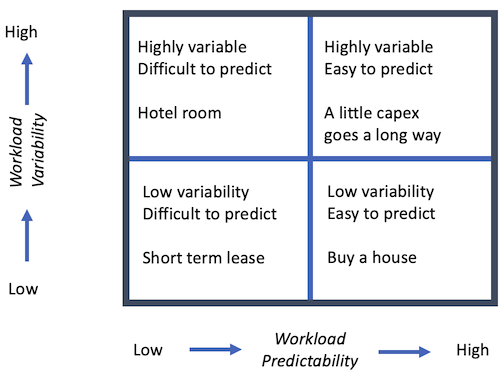Public Cloud…
Costs $1 Trillion in Market Cap
Sarah Wang and Martin Casado of Andreeson-Horowitz assert that cloud spend is reducing enterprise values of tech companies by a trillion dollar. Some excerpts…
There is no doubt that the cloud is one of the most significant platform shifts in the history of computing.
The cloud also helps cultivate innovation as company resources are freed up to focus on new products and growth.
“Repatriation results in one-third to one-half the cost of running equivalent workloads in the cloud”
Across all our conversations with diverse practitioners, the pattern has been remarkably consistent: If you’re operating at scale, the cost of cloud can at least double your infrastructure bill.
It’s becoming evident that while cloud clearly delivers on its promise early on in a company’s journey, the pressure it puts on margins can start to outweigh the benefits, as a company scales and growth slows.
The point of this post isn’t to argue for repatriation, though; that’s an incredibly complex decision with broad implications that vary company by company.
The cloud paradox…You’re crazy if you don’t start in the cloud; you’re crazy if you stay on it.
Suggestions: rely heaving on KPIs; implement proper incentives; relentless and continuous optimization; think through repatriation and do so incrementally if at all.
…Provides Incredible ROI
Venturebeat published an opinion piece disputing the claim by Wang and Casado. Instead Venturebeat claims cloud spend has an ROI to it. Some excerpts…
In our view, a generalized debate over whether on-prem environments are cheaper to operate than cloud is incredibly simplistic.
…the major benefits of the cloud are often related to revenue, not cost.
Two major benefits: acceleration of time-to-market cycles. The possibility of rapid expansions in infrastructure (within or even across geographies) to capture revenue blooms.
The fact that these deployments were poorly architected or were better-suited to run on-prem hardly means that all cloud workloads are
If they can be cloned 1:1 in a datacenter, then companies should always consider re-architecting the workload to take advantage of cloud-native technologies.
If you’re running large workloads in the public cloud, it’s not time to panic. It’s highly unlikely you are wasting half or two-thirds of your infrastructure costs by running in the cloud without any incremental benefits to show for it.
Our position is that the distribution of workloads will be much more nuanced than either article assumes. It will take a variety of infrastructure strategies to host the variety of workloads needed today and in the future. Data and processing demand at the edge is growing exponentially. How does “the cloud” help with that?
Sometimes you need a hotel room, sometimes you need to lease an apartment and sometimes you need to buy a house.
There are many requirements to consider when picking a new home for our workload. Security, performance, tech stack, flexibility, predictability, scalability and cost all matter.
Some workloads have security or performance requirements that require they be in a specific geographic location or even in a specific building physically connected to another device. Some have little to no more than basic security or compliance requirements.
There are also some workloads that that inherently should or can not run “in the cloud.” Workloads that are written from the bottom up on a providers services inherently has to stay in the cloud. But some workloads, like those needed at the edge, inherently cannot rely on “cloud” like elasticity off in a different geography. Content delivery networks are an example of workloads that can’t just be moved to the cloud – they sort of are like the cloud themselves.
For this article, let’s assume that security and performance requirements can be met in either the public cloud or your own environment. For traditional server based workloads, of which there are many, we often refer to this framework.

You may ask how can you have a low variable workload that is unpredictable? Most startup SaaS companies have little variability overtime but also very little predictability as to when they will begin to achieve exponential growth. This is the scenario that Andreesen refers to…at some point the exponential growth has turned into a huge amount of the workload becoming low variability and highly predictable…time to buy a house. Venturebeat would say – without the public’s cloud elastic capex-free model, the startup SaaS would never have been able to innovate and launch.
Is that a wasted spend, or a huge ROI or both?


